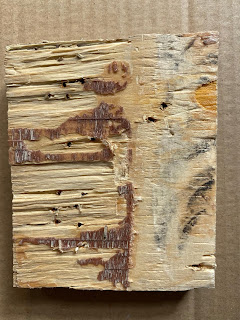We live in desperate times, and I'm desperate to write. You know how that is.
Will anyone read this? Likely not.
Will anyone read this? Likely not.
Have you ever tried to take apart an inexpensive arm chair? Again, likely not.
We found one on the side of the road, and being frugal, or whatever, carted it back home. I insisted on a 2-week quarantine in the garage to let the infecting fleas, ticks, earwigs, ants, bedbugs, bees, wasps, aphids, et al, escape. Also mice and other small animals.
 |
| This is a much nicer new chair, but you get the idea. Its big. |
We dragged it onto the porch, which converted the space into a surreal painting -- tiny room with enormous chair, in the style of Magritte. Then chair went back got the garage. We wanted to get rid of it, but once you've taken ownership things get a lot more difficult.
We left it on the curb. No one wanted it. Then it got rained on and No One wanted it. We were stuck with it, but I had a plan of sorts: dissemble he chair and throw it away bit by bit. Sort of the way POWs got rid of tunnel dirt in movies.
The chair was really a fold-out footrest deal, with a fair amount of metal parts. Those were relatively easy to disengage. And people want scrap aluminum or steel or whatever alloy that was.
The chair was really a fold-out footrest deal, with a fair amount of metal parts. Those were relatively easy to disengage. And people want scrap aluminum or steel or whatever alloy that was.
I assumed this thing was made in Canada, largely because the U.S. stopped making furniture when I was about 2 or 3 years old. Deep within the chair, far from any casual shopper's view, was a small slip of (stapled) piece s of paper, addressed to everyone and no one.
The chair was "45 percent foam...55 percent polyester" -- no talk of wood or metal-- made by El Ran Furniture LTD.../Point Caire, Quebec.
The chair's serial number, in the event of its being stolen and recovered, was 100225724002.
My wife told me that taking apart the chair was a waste of time and that I would probably injure myself. However, a person has to do with a person has to do.
El Ran be dammed.
The chair was "45 percent foam...55 percent polyester" -- no talk of wood or metal-- made by El Ran Furniture LTD.../Point Caire, Quebec.
The chair's serial number, in the event of its being stolen and recovered, was 100225724002.
My wife told me that taking apart the chair was a waste of time and that I would probably injure myself. However, a person has to do with a person has to do.
El Ran be dammed.
I took a sledge hammer to it, without much effect. The cloth covering of some synthetic fiber held the rest of the chair together and was surprisingly resilient. Not like a sheet of cotton. More like bullet resistant Kevlar.
I pried it apart one snowy evening, leaving three main parts connected by the connective tissue of textile. The carcass had two arms. a back devoid of fill. It was all wood.
But it had scant screws and other expensive (?) joiners. Mostly it was held together by staples.
Not little staples that hold school papers together, although there was smaller sized staples. The plywood and pine of the chair were striven by enormous staples, spread intentionally and also willy-nilly.
Staples held the cloth together, which in turn kept the wood from coming apart. Like skin.
No, this was nothing like dissecting a body. Not even close.
I imagined the El Ran factory floor: young blond, scruffy men with staple guns, lunging and stapling in a mad cloud. Occasional laughter and swearing as they installed staples in devil-may-care insouciance.
I removed staples by hammering the backsides of plywood, prying them loose with a crowbar and smaller similar tools. Leverage was usually tricky, as you could imagine. Brute force sometimes worked, but often left half staples, sharp as needles sticking out of the wood in unpredictable places.
I began to imagine how it was built. The workers don't call them staples, I'm sure. They are either "connectors" or some Canadian slang only known to chair assemblers. How are the staples installed? My mind sees young (blonde) men going crazy with enormous staple guns. Who gets stuck. with the tiny staples? Either the oldest or the youngest workers.
Maybe small staples are a reward for service.
I have cleared a small piece of plywood and a leg of staples.
There are a few more lurking, I know. Staples, unlike nails, bend, making them difficult to remove. Those scruffy guys knew what they were doing.
I began to imagine how it was built. The workers don't call them staples, I'm sure. They are either "connectors" or some Canadian slang only known to chair assemblers. How are the staples installed? My mind sees young (blonde) men going crazy with enormous staple guns. Who gets stuck. with the tiny staples? Either the oldest or the youngest workers.
Maybe small staples are a reward for service.
I have cleared a small piece of plywood and a leg of staples.
There are a few more lurking, I know. Staples, unlike nails, bend, making them difficult to remove. Those scruffy guys knew what they were doing.
 |
| All of the staples removed from oner leg and a small piece of plywood. |



No comments:
Post a Comment